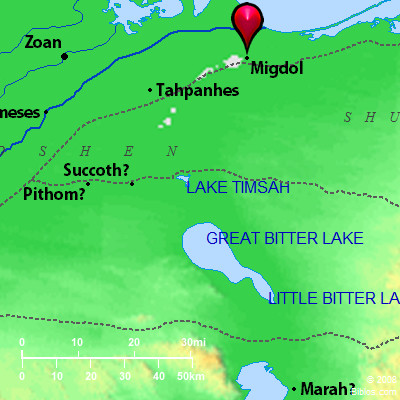Atlas  Migdol and surrounding area
Maps Created using Biblemapper 3.0Additional data from OpenBible.infoOccurrences Exodus 14:2 "Speak to the children of Israel, that they turn back and encamp before Pihahiroth, between Migdol and the sea, before Baal Zephon. You shall encamp opposite it by the sea. Numbers 33:7 They traveled from Etham, and turned back to Pihahiroth, which is before Baal Zephon: and they encamped before Migdol. Jeremiah 44:1 The word that came to Jeremiah concerning all the Jews who lived in the land of Egypt, who lived at Migdol, and at Tahpanhes, and at Memphis, and in the country of Pathros, saying, Jeremiah 46:14 Declare in Egypt, and publish in Migdol, and publish in Memphis and in Tahpanhes: say, Stand forth, and prepare; for the sword has devoured around you. Ezekiel 29:10 therefore, behold, I am against you, and against your rivers, and I will make the land of Egypt an utter waste and desolation, from the tower of Seveneh even to the border of Ethiopia. Ezekiel 30:6 Thus says Yahweh: They also who uphold Egypt shall fall; and the pride of her power shall come down: from the tower of Seveneh shall they fall in it by the sword, says the Lord Yahweh. Encyclopedia MIGDOLmig'-dol, mig'-dol (mighdol; Magdolon): This name ("the tower") is applied to two places on the east frontier of Egypt.
1. Exodus 14:2; Numbers 33:7:
In Exodus 14:2 Numbers 33:7, the Hebrew camp, on the march from Etham after they had "turned" (apparently to the South), is defined as `facing Pi-hahiroth, between Migdol and the sea, over against Baal-zephon.' It is thus to be sought (see EXODUS) West of the Bitter Lakes, and may have been a watchtower on the spur of Jebel 'Ataqah. Israel was supposed to be "entangled in the land," and shut in in the "wilderness," between this range and the Bitter Lakes, then forming the head of the Red Sea. The exact site is unknown. In about 385 A.D., Silvia, traveling from Clysma (Suez), was shown the sites above mentioned on her way to Heroopolis, but none of these names now survive.
2. Jeremiah 44:1; 46:14:
In Jeremiah 44:1; Jeremiah 46:14, a Migdol is noticed with Memphis, and with Tahpanhes Septuagint "Taphnas"), this latter being supposed to be the Daphnai of Greek writers, now Tell Defeneh, West of Qantarah. The same place is probably intended in Ezekiel 29:10; Ezekiel 30:6 (compare 30:15-18), the borders of Egypt being defined as reaching "from Migdol to Syene" (see the Revised Version margin), as understood by the Septuagint translators. The Antonine Itinerary places Migdol 12 miles South of Pelusium, and the site appears to have been at or near Tell es Samut, the Egyptian name, according to Brugsch (Hist, II, 351), being Samut. This Migdol was thus apparently a "watchtower" on the main road along the coast from Palestine, which is called (Exodus 13:17) "the way of the land of the Philistines," entering Egypt near Daphnai.
These Sites Not Identical.
We are specially told that this was not the route taken at the exodus, and this Migdol cannot therefore be the same as (1), though Brugsch, in consequence of a theory as to the exodus which has not been accepted by other scholars, has confused the two sites, as apparently does the Antonine Itinerary when placing Pithom on the same route leading to Zoan. Brugsch (Geography, III, 19) supposes the Egyptian town name Pa-Ma'kal (with the determinative for "wall" added) to stand for Migdol, but the prefix "Pa-" ("city") seems to show that this word is purely native, and not Semitic, to say nothing of philological objections. This town may, however, have lain in the required direction, according to a scribe's report of the time of Seti II (or about 1230 B.C.).
As much confusion has been created by quoting this report as illustrative of the exodus, the actual words according to Brugsch's translation may be given (History, II, 132): "I set out from the hall of the royal palace on the 9th day of Epiphi, in the evening, after the two servants. I arrived at the fortress Thuku (T-k-u) on the 10th of Epiphi. I was informed that the men had resolved to take their way toward the South. On the 12th I reached Khetam. There I was informed that grooms who had come from the neighborhood (of the "sedge city") reported that the fugitives had already passed the rampart (Anbu or "wall"), to the North of the Ma'ktal of King Seti Minepthah." As to the position of this "wall," see SHUR.
C. R. Conder
MIG'DOL, associated with the Exodus, is not known as to its site. The word means "Tower." Strong's Hebrew H4024: Migdola city on the N.E. border of Egypt |




